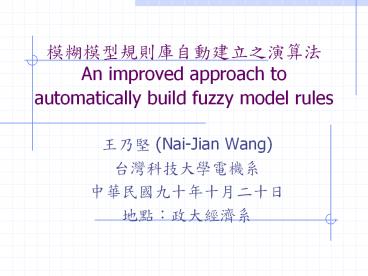??????????????? An improved approach to automatically build fuzzy model rules - PowerPoint PPT Presentation
Title:
??????????????? An improved approach to automatically build fuzzy model rules
Description:
Title: An improved approach to automatically build fuzzy model rules Author: Simon Last modified by – PowerPoint PPT presentation
Number of Views:142
Avg rating:3.0/5.0
Title: ??????????????? An improved approach to automatically build fuzzy model rules
1
??????????????? An improved approach to
automatically build fuzzy model rules
- ??? (Nai-Jian Wang)
- ?????????
- ????????????
- ???????
2
Outline
- Motivations
- The concept of system identification
- The improved algorithm
- Simulations and Discussions
- Conclusions and Future Works
3
Motivation
- Only I/O data
- Model construction
- I/O relation
- Modification
4
The concept of system identification
Structure Identification I a Input candidates
Structure Identification I b Input variables
Structure Identification II a Number of rules
Structure Identification II b Partition of input space
Parameter Identification Parameter Identification
5
Takagi and Sugenos model
6
Sugeno and Yasukawas model
7
Fuzzy modeling
8
To decide the number of rules
9
Fuzzy C-means clustering
10
To determine the number of rules
11
Coarse fuzzy modeling
- Fuzzy C-Regression Model (FCRM)
- Premise parameters generation
- Consequent parameters generation
12
Fuzzy C-Regression Model (1)
13
Fuzzy C-Regression Model (2)
14
Premise parameters generation (1)
15
Premise parameters generation (2)
16
Premise parameters generation (3)
17
Premise parameters generation (4)
18
Consequent parameters generation
19
Fine tuning
20
The steepest decent method
21
The gradient of objective function (1)
22
The gradient of objective function (2)
23
The gradient of objective function (3)
24
Stop condition
25
Example 1 (1)
Rule
3.095 3.201 3.518 -0.249 -0.265
1.477 1.511 3.518 -0.249 -0.265
2.751 2.406 6.504 -0.672 -0.469
2.072 2.156 6.504 -0.672 -0.469
2.828 2.437 4.842 -0.381 -0.421
1.831 1.839 4.842 -0.381 -0.421
2.667 2.805 4.136 -0.387 -0.357
1.026 1.369 4.136 -0.387 -0.357
2.897 2.544 5.052 -0.559 -0.243
2.005 1.924 5.052 -0.559 -0.243
26
Example 1 (2)
The optimal parameters
Rule
3.806 2.842 5.165 -1.094 -0.224
0.957 1.471 5.165 -1.094 -0.224
2.767 1.853 4.741 -1.117 -1.072
1.080 0.657 4.741 -1.117 -1.072
2.023 2.682 3.671 -0.572 -0.884
0.590 1.323 3.671 -0.572 -0.884
2.973 3.221 3.447 -0.317 -0.551
0.951 1.120 3.447 -0.317 -0.551
2.894 2.363 8.415 -0.376 -0.785
1.984 2.230 8.415 -0.376 -0.785
27
Example 1 (3)
28
Example 2 (1)
29
Example 2 (2)
30
Example 3 (1)
31
Example 3 (2)
32
Conclusions and Future Works
- ????,???
- ????????
- ???????????????
- ?????????????
- ??FCM??????
- ????????????????
33
Least-squares estimator































